So, here was the plan: I had been unsuccessful in locating a copy of Poppyland by Clement Scott when we toured the North Norfolk coast last year, so I would find a copy in Norwich. It does have, as I was told by a very excited bookseller,”more bookshops than Oxford and Cambridge combined,” so it shouldn’t be too hard. I would wander around some of the fine rare and antiquarian booksellers, ask for the book, discuss literature with them and take in some of the sights on the way. Brilliant plan. My long quest would take me around some interesting bookshops and allow me to catalogue the literary sites of the capital of East Anglia.
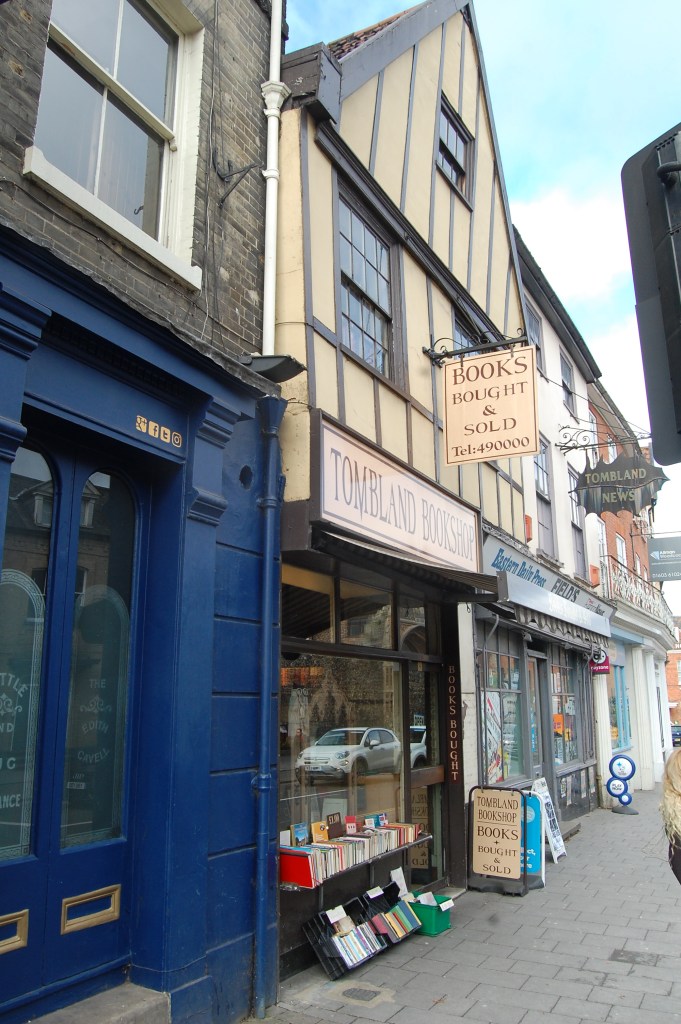
Mrs P and I were staying at the Maid’s Head hotel, itself a source of inspiration for several writers. We found the hotel with little difficulty, parked up and set off towards the city. My first stop was the Tombland Bookshop, a lovely old shop with a lovely smell of old books. The shop is on two levels: the shelves are arranged on a sort of mezzanine above the main shop and there is a second floor above that. I made my way up and had a look at the local history section. Nothing here. I approached the woman behind the counter. She was a lovely, smiley person and told me that her name was ‘Phillipa’. “Poppyland?” she asked me “I’m not sure. Who’s it by?” My mind went completely blank. “I don’t know.” I said. She gave me a look that I get in a lot of booksellers as I search the recesses of my mind for information. A quick look on a excellent website with a comprehensive database of literature (yes, reader, this one!) and I was able to recall the name of Clement Scott. Phillipa checked her catalogue. “yes, we have one” she said.
Well. That was a bit of a blow! I had planned to spend all day looking for it, finally tracking it down in an obscure, out-of-the-way bookshop in some little trod backstreet. I wasn’t supposed to find it in the first shop I went into. Phillipa said it would take her a while to track down and I promised to collect it later in the day. I left the shop and walked through the Elm Hill district of town. Cobbled streets wind between medieval buildings and old, flint-built churches. There are a ridiculous number of churches in Norwich. I found one street corner where there were three. Some are still in use, most have been converted to other purposes; there are 57 in all. Something to do with rich wool merchants wanting to show off their wealth. The medieval equivalent of a Porsche, I suppose.
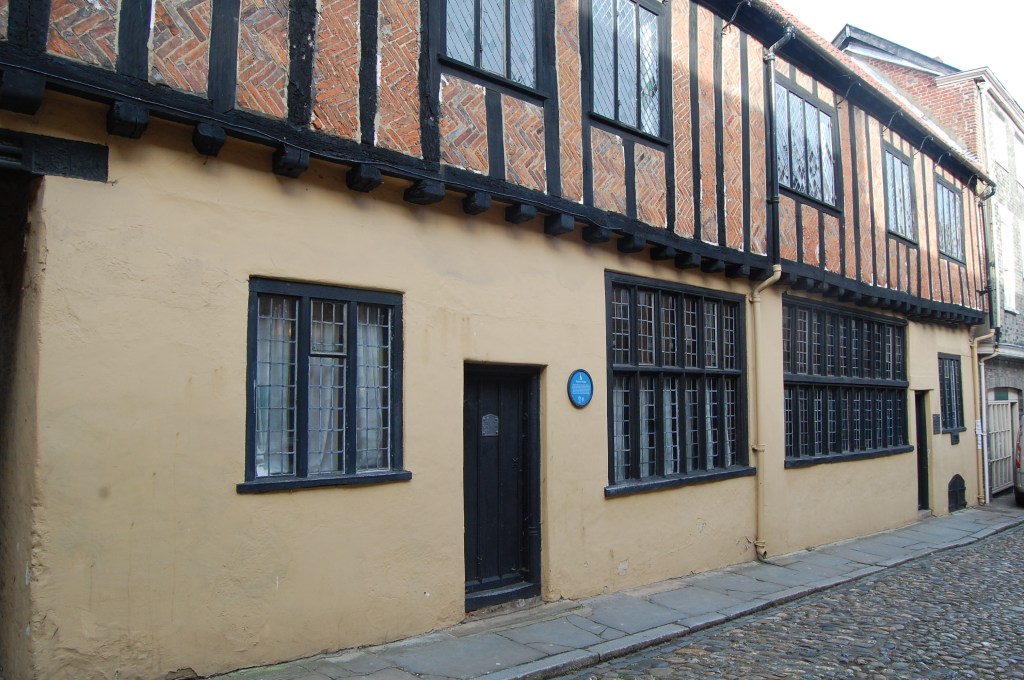
I passed the home of the Paston family. They were a wealthy middle-class family living in Norwich in the 15th Century. They documented everyday life for a family of their class through a series of letters, which give a fascinating insight into life in medieval England. Opposite this lovely old building is the Dormouse bookshop. A tiny space, crammed with old volumes and a particularly good collection of old children’s and comic books. I had a short chat with the owner, mostly about the weather. Booksellers are a lovely, chatty bunch of people, willing to talk about anything. It is a rarity to leave a second-hand bookshop without having a chat. My theory is that they spend all day breathing the spores from the mould that grows on old books and it sends them a bit loopy.
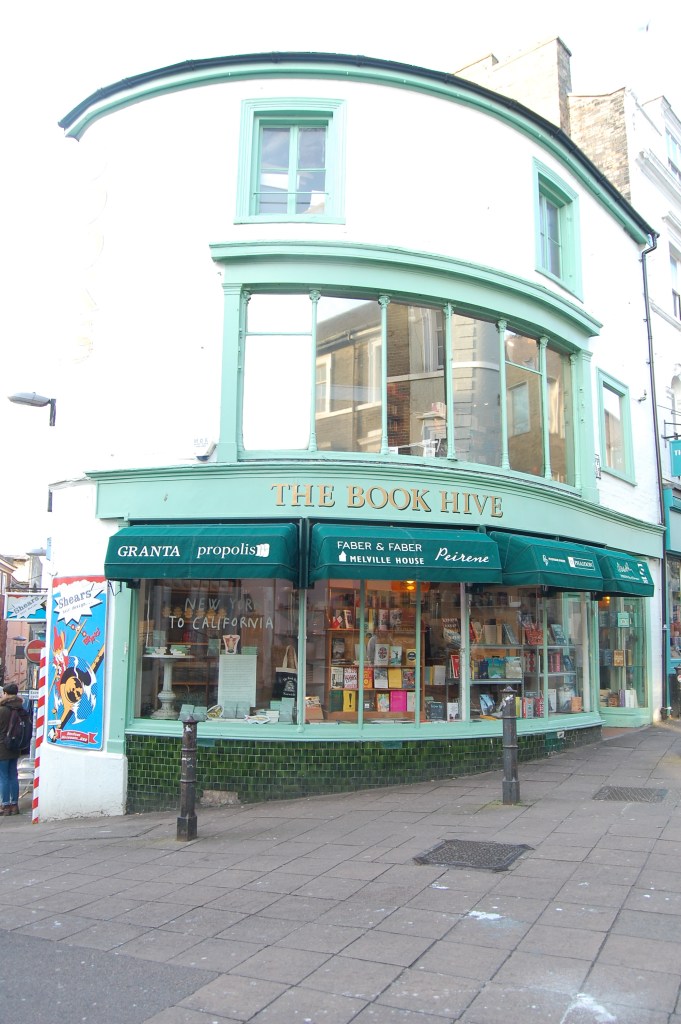
Leaving the shop, I walked along cobbled streets to London Road, in the city centre. It wasn’t very far. In fact, it was surprisingly close. In my youth, when I was dragged unwillingly around Norwich by parents, Elm Hill to city centre seemed a vast distance. Today, it took me about five minutes to walk there. On the corner of London Road is the Book Hive. This one sells new books and is a lovely little shop, spread over two levels, with a panoramic bay window upstairs. They have a good selection of books, displayed with the covers on show so you can appreciate the artwork. The have a very good children’s section. I was particularly gratified when a young family (harassed looking woman with a pushchair and two young boys) came in to look at books. Margaret Atwood claims this as her favourite bookshop and wrote some of The Heart Goes Last in a studio above the store.

Opposite the book Hive is Opie Street, named after the poetess and abolitionist writer Amelia Opie. There is a statue of her halfway along the street, perched on top of a shop looksing down on the shoppers below, most of whom walk by without even noticing. There is an old building at the top of the street where young Amelia Alderson lived with her parents before she married John Opie, the Welsh artist. A plaque records her residence here. The pictures of her as a young woman show her to be an incredibly beautiful, intelligent looking woman but then, these were all painted by her husband. The street was renamed Opie street in 1867 in recognition of her achievements. Apparently, the Victorians didn’t care for the street’s original name: Gropecunte Lane.
Back down the hill, away from the castle and through the marketplace leads me to the Maddermarket theatre. The building itself is an unremarkable modern structure but a plaque on the wall tells us that William Kemp, Elizabethan clown and former member of Shakespeare’s acting company, finished his morris dance from London to Norwich at this spot. Kemp was something of a celebrity in his day. He has been associated with two iconic Shakespearean characters: Falstaff in Henry IV and Dogberry in Much Ado About Nothing; and undoubtedly played many more. His gambols, his songs, his flashes of merriment were wont to set the table on a roar. The crowds loved his ad-libbing and amusing antics; his fellow actors, not so much. Kemp left (or was kicked out of) Shakespeare’s company in 1600 and embarked on his 100 mile morris dance as a publicity stunt. He completed the dance here after nine days describing it as a “nine daies wonder.”
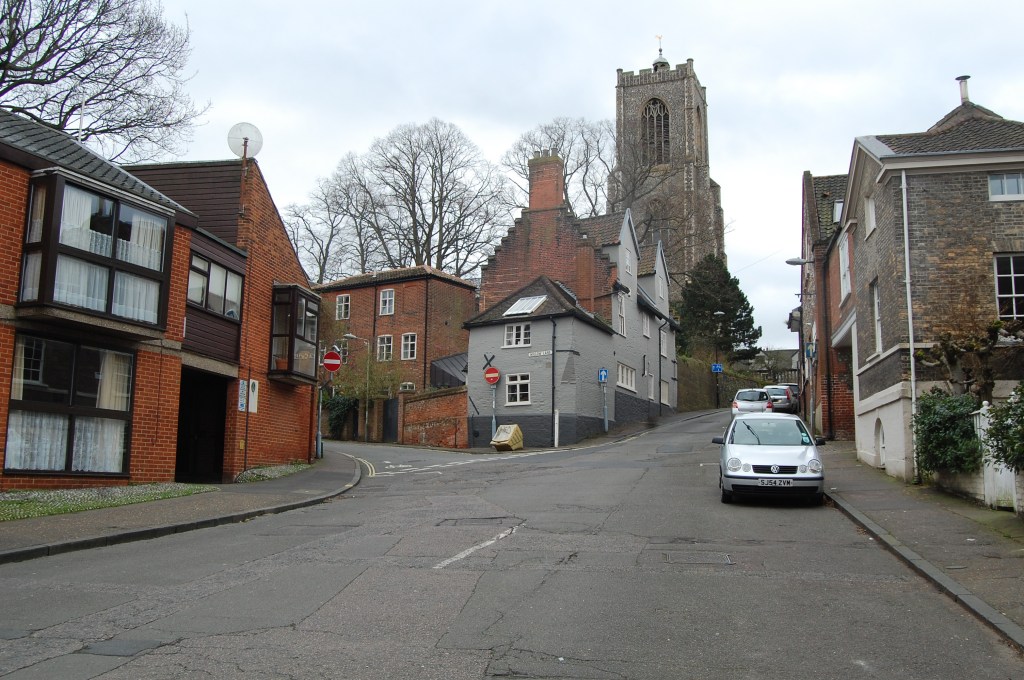
From here, it took me about a five minute walk along Pottergate to Cow Hill (you’ve got to love Norwich street names!) and Willow Lane. This lovely old street has a plaque on the wall of a modern block of flats, recording that George Borrow once lived here. Borrow wrote a couple of well-known novels but is chiefly remembered for Wild Wales, a record of a trip he took through Wales in 1862. Part of his childhood was spent in Norwich and he attended school here. Willow Lane is a pleasant little street to walk up and will lead you eventually back to the market square. From here, turn right and walk alongside the 20th century City Hall: a square, brick building with a tower, a columned portico and art deco lions. It reminds me of nazi architecture but the artistic touches distance it from the starkly utilitarian. Next door is the Millennium centre: a modern glass fronted building that houses the most-visited public library in the country.
It was busy. As well as the library there is a Pizza Express, a coffee shop, a citizens’ advice bureau and a tourist information office. There was an exhibition of knitting in the foyer. Hundreds of Norfolk grannies had been putting needle to wool in aid of charity and the fruits of their labours where there for all to see. I stopped in front of a magnificent model of Sandringham House, all constructed from wool, complete with wooly trees and wooly royal family. Inside the library there were three floors of books, a local history research centre, a small business advice centre. They have exhibitions and talks throughout the year. Oustide the building is a performance space. Everywhere there were children: families with toddlers, older children doing research for school projects (one very eager girl researching gay history with her bemused and embarrassed looking grandfather); kids swarming between the shelves searching for books to help them pass the holidays. This is what libraries should be like. Not quiet and dusty shelves with grumpy librarians but vibrant places of entertainment, fit for a family day out. I was extremely impressed.

I stayed for a little look around but it was now fast approaching lunchtime: time to meet Mrs. P. We had arranged to meet in the Bell, a very old hotel in the shadow of the castle. Young Arnold Wesker once worked in the kitchens here whilst simultaneously seeking success as a playwright. The pub is now run by Wetherspoons: a British pub chain run by ‘eccentric’ Tim Martin. I have a problematic relationship with Wetherspoon’s free houses. On the plus side, they are clean, cheap, do good food at very reasonable prices and have a good selection of beer, all of which is served perfectly. On the other hand, they smell like a chip shop, generally employ so few bar staff that you are always kept waiting and, when you do get served, the menus and beer range in no way reflect local culture or producers. Everything is homogenised; it’s a bit like having lunch in a motorway service station. In fact, they have a few branches in motorway service stations. Worst of all, they suck the character out of any place they inhabit. They rip out old interiors and put in light wood fittings and the sort of art you see in dentists’ waiting rooms. Anyway, we both had fish and chips and it was hot and delicious and very cheap. I had a pint of Greene King, it being from Bury St. Edmunds, the closest brewery to Norwich but where was the Woodforde’s, the Panther and the Wolf beers? Where were the Cromer crabs or the Norfolk Dumpling (a delicious dish comprised of bacon and onions in a suet crust)?
After lunch I wandered down to the riverside and St. Julian’s church. St. Julian was a nun who had a cell on the south side of the church. In 1373, she lay on her death bed, certain that she was approaching the end of her life. That night, she had 13 visions, in which she was visited by saints and angels. She recovered the next day and was moved to write Divine Revelations, an account of these visitations, making her the first female writer in the English Language. The remains of her cell are no longer there but there is a little shrine on the site. If you are of a religious persuasion, you can light a candle and meditate. If you (like me) are not, you can sit down and have a think. There is a visitor centre next to the church where some lovely people welcomed me in and even offered to make me a cup of tea. This is an offer I can rarely turn down but this time it came too soon after lunch. I politely declined and satisfied myself with looking at the books and keepsakes for sale.
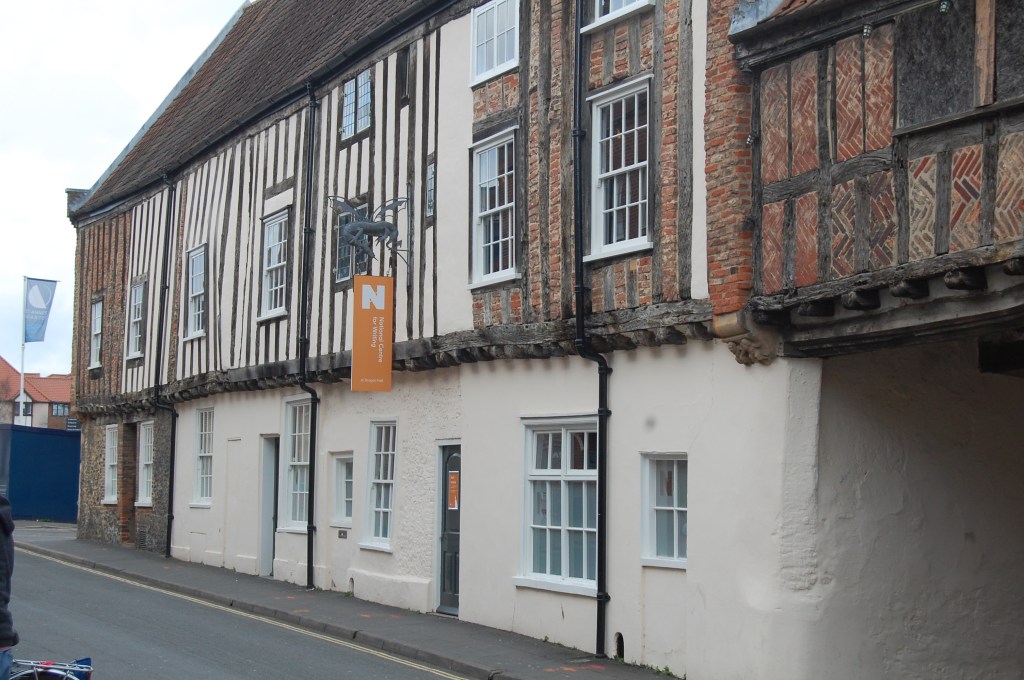
A short walk past the church to King Street brings you to Dragon Hall. This medieval merchants’ hall, with parts dating from the Saxon era, is home to the National Centre for Writing. Norwich was awarded International City of Literature status in 2015, due to its love of the written word, its many bookshops and its libraries. The National Centre for Writing teaches young people to unleash their creativity through courses and workshops. They also have talks and mentoring to nurture literary talent in people of all ages. There is little to see here, unless you happen to be taking a course or attending a talk, and today it was all closed up anyway, so I trudged back up the hill towards the castle and the climax of my visit.
When I was eight, Norwich Castle was my favourite place in the world. As well as an Art Gallery and wonderful museum, they have a castle keep, where a tour will take you to the deepest, darkest dungeons and to the highest battlements. There are implements of medieval torture and a well, into which you can drop a penny and watch it sail into the darkness below. I arrived after climbing the considerable hill from the city below, through the castle grounds, where groups of young people passed the time with an aromatic herbal cigarette and ‘alright’ed me as I passed, I nodded in return (as a sixth form teacher, I speak fluent Young-person and could probably get by, but they looked slightly anxious and I didn’t want to intrude). I was informed by the charming lady on the admissions desk that in 15 minutes the price would drop to 2 pounds and I should wait until then. I took a turn around the castle keep to pass the time. From here, you can see the entire city: the Carrow Road stadium, where the Canaries play to the delight of city dignitaries, such as Delia Smith and Stephen Fry, who are both avid fans. I could see the Cathedral in the distance, the City Hall, the Forum and the Guildhall. I counted 15 churches from Castle Hill, so tightly packed together that their towers appeared to touch.

Back at the museum, I made my way to the rotunda and started with the collection of Norfolk wildlife. It was all here. Exactly as I remembered it. Stuffed birds and animals in clever little dioramas of Norfolk habitats: salt marsh, heathland, broadland and breckland. My favourite was of ducks coming in to land on a beach and it was still here! Elsewhere there were the lions and monkeys I remembered: still here with the same daft expressions on their faces. I had a quick wander around the art gallery, featuring the work of the Norwich school of artists, and was happy to see they had a small display about Amelia Opie, featuring one of her husband’s reverential portraits and some of her personal belongings. After that, I went through Romans and Iceni, which had been considerably updated and improved since I last visited, and into the keep. I was slightly disappointed that the prehistoric skulls were no longer there but, mostly, it was all exactly as I remembered. The Keep had been cleared out, ready for a major refurbishment: the suits of armour and ceremonial dragons had gone and the well was now covered over but they still did tours of the dungeons and battlements too.
I was gratified to have revisited this happy part of my childhood and looked forward to meeting Mrs. P for tea in the café. It was closed. Never mind, we had a perfectly good hotel to go back to so we went for tea there. The Maid’s Head was extremely comfortable: the staff were polite and our room was well-sized. In the evening we ordered drinks and sandwiches from the bar, which we ate in front of the fire in the lounge. We were the only people in there. It is, as JB Priestley observed, a rambling place. It has been added to many times over the years and seems as if you could get lost in the miles of corridors. It has been the destination of choice for many visitors to Norwich over the years: as well as JB Priestley, PD James stayed here, including it as a location in Devices and Desires. It also features in LP Hartley’s The Go Between and, after staying here in 1969, Philip Larkin declared: “Norwich is ghastly.”
It isn’t ghastly; it’s a lovely little city. It has all the markets, shops, cinemas you would expect, along with some lovely bookshops, a wonderful museum and art gallery and a magnificent cathedral. Eight-year-old me still hasn’t changed his mind; it is still one of my favourite cities. It really is, as the roadsigns declare, “a fine city.”
If you are interested in the literature of Norwich and Norfolk, I highly recommend the Literary Norfolk website. It has been immensely useful in my research.
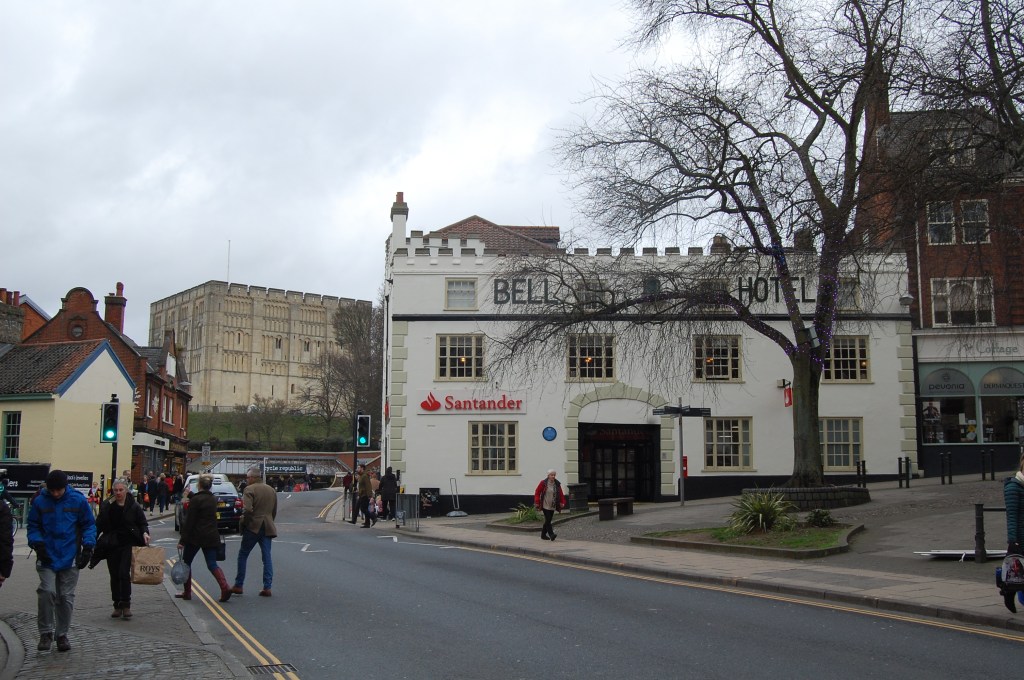
Leave a comment